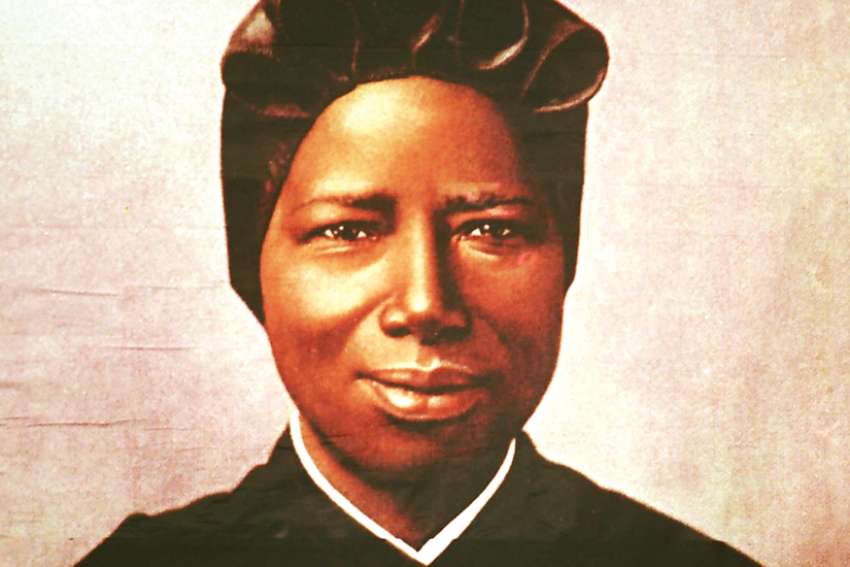There is a Sudanese proverb which states, “Be accustomed to hardship, for God’s endowment never lasts.” The heroic life of Sudan’s patroness had plenty of hardship. Bakhita was sold into slavery and brutally tortured. Contrary to the proverb though, God’s endowment did last.
Born to a loving family in Darfur, Sudan, Bakhita did not know of suffering, but soon enough suffering would find her. At the age of nine years old, Bakhita was abducted by slave traders; a tragic fate common amongst Sudanese women both then and now. Over a span of 11 years, until the age of 20, she was bought and sold five times. Human freedom was a friend taken from her.
Her Arab slave masters forcibly converted her to Islam. In fact, nothing of her past was to remain, not even her name. The name Bakhita means “fortunate” or “lucky one” in Arabic; a providentially ironic name given to her by her kidnappers. It would be a decade later before she would come to understand the significance of this prophetic name. A name given out of mockery by her persecutors would become the name called upon by those seeking the intercession of this saint.
Bakhita suffered fearsome physical and psychological tortures. One of Bakhita’s owners, a Turkish general and his family, were the source of unspeakable pain.
“During all my years I stayed in that house, I do not recall a day that passed without a wound or other. When a wound from the whip began to heal, other blows would pour down on me,” recalled Bakhita. Her owners would fill her open wounds with salt to ensure permanent scarring. The continuous flogging left her with 144 scars across her bosom, belly and right arm. Bakhita was only 13 years old.
God’s endowment made its first payment in the form of Bakhita’s fifth owner, Callisto Legnani, an Italian diplomat in Sudan. The absence of violence and punishment opened Bakhita’s heart to the possibility of a merciful master. When the Legnani family returned to Italy, they took Bakhita home with them. But Italy did not permit slave-holding, so Bakhita was freed and found refuge with the Canossian Sisters in Venice. Another payment from God’s endowment. Here she discovered the “Master of masters.”
Benedict XVI, in his encyclical on hope, Spe Salvi, lifted up Bakhita as a model of hope.
With the sisters, Bakhita encountered the “God from childhood who (she) had felt in her heart without knowing who He was.” Benedict recounts that Bakhita came to know this God as “Paron” in the Venetian dialect. This “Paron” had been subject to flagellation Himself.
As a light brightens the darkest of spaces, hope now illuminated this suffering soul. Pope Benedict explains how her hope was no longer for a caring master — what she had yearned for when she was maltreated. Rather Bakhita now had a “great hope” that “I am definitely loved and whatever happens to me — I am awaited by this Love. And so, my life is good.”
At the age of 20, Italian civil authorities granted Bakhita freedom. A few months later, Bakhita received the sacraments — Baptism, Eucharist and Confirmation — with the name Josephine Margaret from then Archbishop Giuseppe Sarto, the future Pope St. Pius X.
Soon after, on the feast of the Immaculate Conception, Bakhita took her perpetual vows with the Canossian Sisters and spent the rest of her life working as the cook, sacristan and porter of her community. The former slave, now a sister and future saint, Bakhita called upon God as “the Master!”
Human trafficking and slave trading are still prevalent in Sudan today as nearly three million people are at risk of being exploited and the majority being women. The country has been described as the “source” and “transit point” for human trafficking.
St. Josephine Bakhita, the flower of the African desert, serves as a powerful intercessor for the victims of these heinous crimes as well as astonishing forgiveness for the perpetrators.
“If I was to meet those slave raiders that abducted me and those who tortured me, I’d kneel down to them to kiss their hands because, if it had not been for them, I would not have become a Christian and religious woman,” Bakhita said.
The slave girl mistreated became a beloved religious in Venice, known to all with affection as their “black mother.” The girl forcibly converted to Islam became a Catholic saint. A life marked by hatred and despair became a model of love and hope.
(Fr. de Souza is editor-in-chief of Convivium.ca and a pastor in the Archdiocese of Kingston.)


